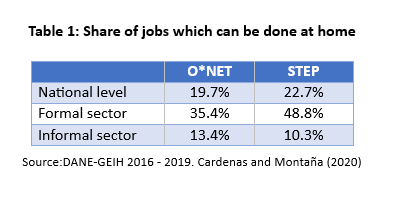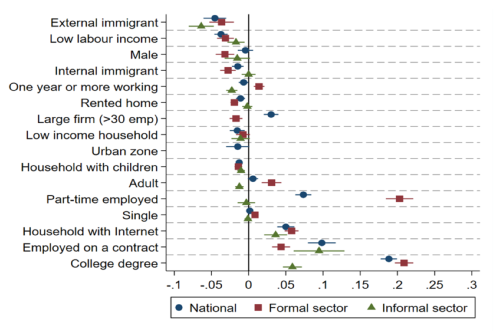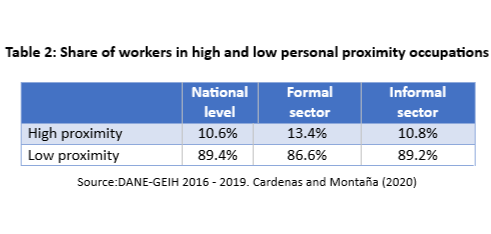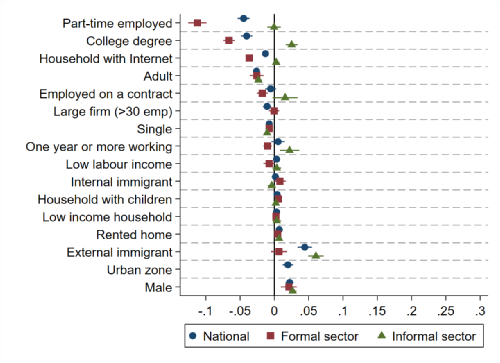IER News & blogs
Measuring the share of workers in work-from-home and close personal proximity occupations in a developing country – Blog by Jeisson Cardenas Rubio and Jaime Montana Doncel*
 The COVID-19 pandemic and its social distancing measures have brought unprecedented socio-economic challenges worldwide. One of the most urgent questions is how the labour force will be affected by the pandemic. The answer to this question will have considerable impact on the countries’ productivity, poverty and unemployment rates, etc. Consequently, the measurement of jobs, which can be performed without increasing the risk of contagion, has become a priority in the world. Given rich sources of information such as the Occupational information network (O*NET), more advanced countries such as the United States (U.S.) have started to estimate the number of jobs that can be performed at home (teleworkable jobs) or are at higher risk of contagion because their tasks involve close proximity with others (Dingel and Neiman, 2020; Mongey and Weinberg, 2020).
The COVID-19 pandemic and its social distancing measures have brought unprecedented socio-economic challenges worldwide. One of the most urgent questions is how the labour force will be affected by the pandemic. The answer to this question will have considerable impact on the countries’ productivity, poverty and unemployment rates, etc. Consequently, the measurement of jobs, which can be performed without increasing the risk of contagion, has become a priority in the world. Given rich sources of information such as the Occupational information network (O*NET), more advanced countries such as the United States (U.S.) have started to estimate the number of jobs that can be performed at home (teleworkable jobs) or are at higher risk of contagion because their tasks involve close proximity with others (Dingel and Neiman, 2020; Mongey and Weinberg, 2020).
Generating statistical data for Colombia
Less advanced countries such as Colombia (where unemployment and informality rates are high - around 10.5% and 46.2%, respectively in 2019) face huge challenges in making such estimations. In these countries, good labour market information is scarce (Cardenas, 2020). To answer the labour force question for Colombia, we have adapted different international work-from-home and proximity measures and estimated the proportion of workers in the corresponding groups according to the Colombian context. With these results, Colombian policymakers have labour market information to make prompt and data-driven decisions. Moreover, this exercise provides evidence that national surveys in developing countries (e.g. household surveys) and international references such as the O*NET can be combined to produce consistent indicators to reduce the impact of the COVID-19 in the labour market.
Thanks to the work conducted by Cardenas (2020) in coding Colombian job titles in the household survey to the International Standard Classification of Occupations (ISCO 08) at four-digit level for the first time and the taxonomies proposed by Dingel and Neiman (2020) and cross-walks between ISCO and SOC-O*NET, based on the 2018 Standard Occupational Classification, we could map the work-from-home occupations in Colombia. We recognise that technologies, skills and tasks required in developing countries might differ from the ones demanded in more advance countries. Thus, work-from-home occupations in the U.S. might not coincide with work-from-home occupations in Colombia. To address this issue, we also adapt the work by Saltiel (2020) who estimated the share of jobs that can be done from home in ten developing countries (including Colombia) with the Skills Toward Employability and Productivity (STEP) survey. This information provides an alternative indicator to measure teleworkable occupations.
How many jobs can be done from home?
Table 1 shows the proportion of jobs that can be done at home. Based on Dingel and Neiman’s (2020) definition, 19.7% of the total workers in Colombia can perform their jobs at home. However, this proportion considerably differs when the population is divided into formal and informal workers. Around 35.4% of formal workers can telework, while only 13.4% of informal workers can do their jobs at home. 
Table 1 shows three relevant points: (1) the share of Colombian workers who can work at home is relatively low compared with the U.S. (around 37%, Dingel and Neiman, 2020); (2) the informal sector might be more affected by social distancing measures because only between 13.4% and 10.3% of these workers can work at home; (3) importantly, definitions based on STEP (Saltiel, 2020) and on O*NET (Dingel and Neiman, 2020) produce similar results. Indeed, for 84.3% of total workers in Colombia, the O*NET and STEP taxonomies categorise them in the same group (non-teleworkable or teleworkable). Thus, the results from O*NET do not drastically differ from other sources of information, and instead, they add more elements to analyse the labour market in developing countries.
Who works in work-from-home occupations?
Additionally, we estimate the characteristics of workers in work-from-home occupations. As shown in Figure 1, workers with a college degree, (written) employment contract or living in households with an internet connection are more likely to have work-from-home occupations. In contrast, male immigrants and workers with a low income (below the minimum wage) are less likely to work at home. In summary, Figure 1 reveals who are the more (or less) vulnerable workers by “stay at home” public policy measures.
Figure 1: Characteristics of workers in teleworkable occupations

Source: DANE-GEIH 2016 - 2019. Cardenas and Montaña (2020)
How many work in close personal proximity occupations?
To answer the question about the share of workers which can continue working without increasing the risk of contagion, we follow Leibovici et al. (2020) who define a high-proximity occupation when, according to the O*NET, its tasks involve close (less than an arm length of distance) physical proximity to other people. Our results for Colombia in Table 2 show that 13.4% and 10.8% of formal and informal workers, respectively, perform activities that involve close personal proximity with others. This result reveals that at least 10.6% of workers at the national level need to have the proper protective equipment and precautions while they are performing their jobs.

Who works in close personal proximity occupations?
Finally, we estimate the characteristics of workers in close personal proximity occupations. Figure 2 shows that part-time employees, workers with a college degree and those living in a household with an internet connection are less likely to have jobs in close personal proximity occupations. In contrast, male immigrants and urban workers are more likely to work in close personal proximity occupations. Consequently, these workers are at a higher risk of contagion in Colombia.
Figure 2: Characteristics of workers in high personal-proximity occupations

Source: DANE-GEIH 2016 - 2019. Cardenas and Montaña (2020)
Conclusion
We reveal that informal, low educated and immigrant workers are those most affected by social distancing measures and that they also tend to be at higher risk of contagion of COVID-19. Additionally, we show that international resources such as the O*NET can be used in a developing country without adding considerable “noise” to the labour market analysis. We are convinced that these kinds of studies will considerably help policymakers to protect workers, especially those with higher economic and health risks.
References
Cárdenas, J. (2020, forthcoming). A web-based approach to measure skill mismatches and skills profiles for a developing country: the case of Colombia. Colombia Científica. Library Catalogue: https://alianzaefi.com/.
Cárdenas, J. & Montaña, J. (2020, forthcoming). Measuring the share of workers in work-from-home and close personal proximity occupations during the Coronavirus crisis in a developing country. Colombia Científica. Library Catalog: https://alianzaefi.com/.
DANE (2019). Empleo Informal y Seguridad Social. Retrieved April 28, 2020 http://www.dane.gov.co/index.php/estadisticas-por-tema/mercado-laboral.
Dingel, J. I. & Neiman, B. (2020). How many jobs can be done at home? Technical Report, National Bureau of Economic Research.
Leibovici, F., Santacreu, A.M. & Famiglietti, M (2020). Social Distancing and contact-intensive occupations j St. Louis Fed. Library Catalog: www.stlouisfed.org.
Mongey, S. & Weinberg, A. (2020). Characteristics of workers in low work-from-home and high personal proximity occupations, BFI White Paper.
Saltiel, F. (2020). Who Can Work From Home in Developing Countries?
* Jaime Montana Doncel is a PhD candidate at the Paris School of Economics and Università degli studi di Torino.
